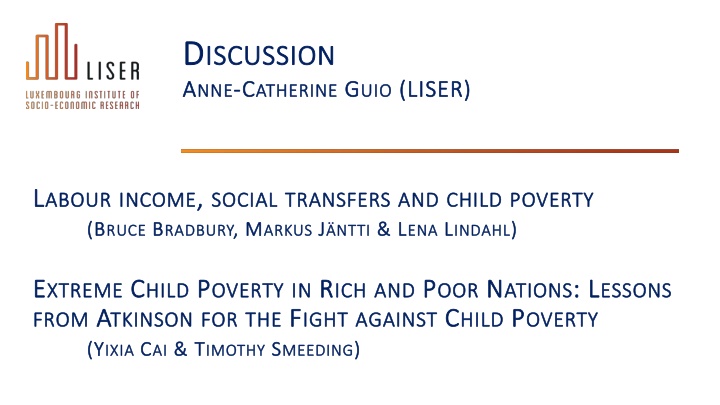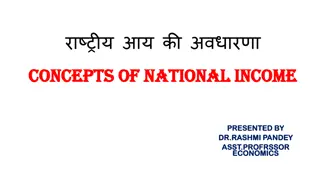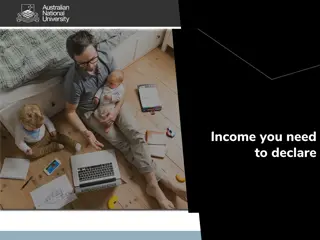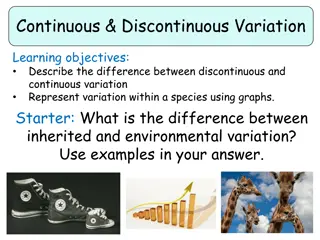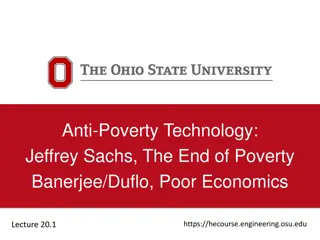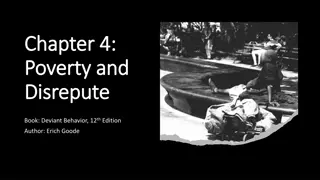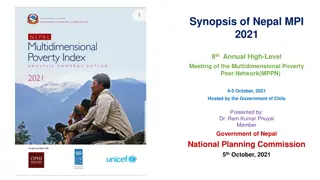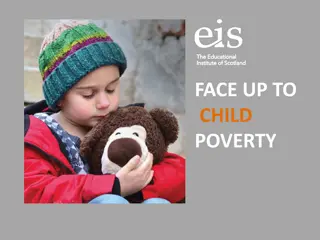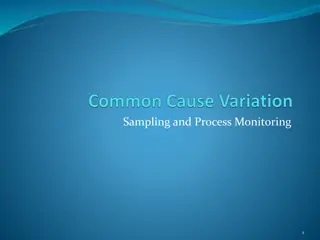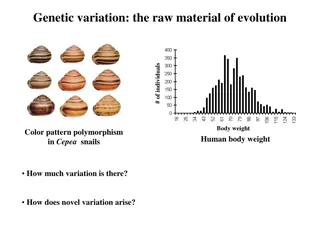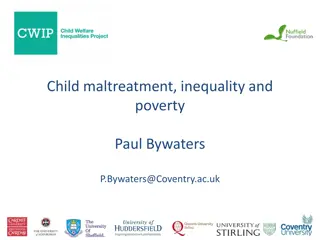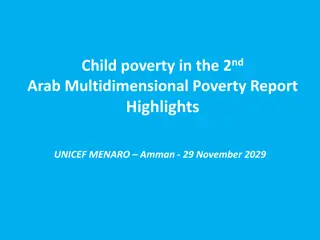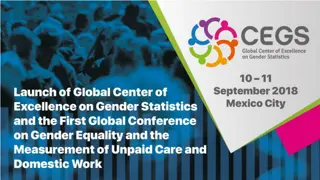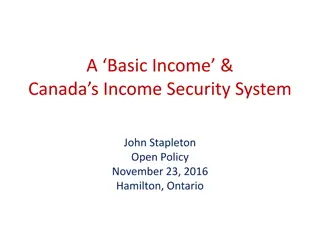Cross-National Variation in Child Poverty and Income Distribution
Explore the factors influencing child poverty across nations, focusing on income distribution and the impact of social transfers. Analyze the characteristics of low-income households with children and the effectiveness of different transfer programs. Gain insights into extreme child poverty in rich and poor nations, examining key components of household resources.
Download Presentation

Please find below an Image/Link to download the presentation.
The content on the website is provided AS IS for your information and personal use only. It may not be sold, licensed, or shared on other websites without obtaining consent from the author.If you encounter any issues during the download, it is possible that the publisher has removed the file from their server.
You are allowed to download the files provided on this website for personal or commercial use, subject to the condition that they are used lawfully. All files are the property of their respective owners.
The content on the website is provided AS IS for your information and personal use only. It may not be sold, licensed, or shared on other websites without obtaining consent from the author.
E N D
Presentation Transcript
D DISCUSSION ISCUSSION A ANNE NNE- -C CATHERINE ATHERINE G GUIO UIO (LISER) (LISER) L LABOUR ABOUR INCOME (B (BRUCE RUCE B BRADBURY INCOME, , SOCIAL RADBURY, M SOCIAL TRANSFERS TRANSFERS AND , MARKUS ARKUS J J NTTI AND CHILD CHILD POVERTY NTTI & L & LENA ENA L LINDAHL INDAHL) ) POVERTY E EXTREME XTREME C CHILD FROM FROM A ATKINSON ( (Y YIXIA IXIA C CAI AI & T HILD P POVERTY OVERTY IN TKINSON FOR FOR THE & TIMOTHY IMOTHY S SMEEDING IN R RICH IGHT AGAINST AGAINST C CHILD MEEDING) ) ICH AND AND P POOR OOR N NATIONS ATIONS: L HILD P POVERTY : LESSONS ESSONS OVERTY THE F FIGHT
LABOURINCOME, SOCIALTRANSFERSANDCHILD POVERTY Aim: Explain the cross-national variation in the relative income of the bottom fifth of children Decomposition approach, very instructive Care about data quality (sensitivity analysis re impact of self-employment income)
S STILL TILLCURIOUS CURIOUSABOUT ABOUT Focus on low wage, low hours, transfers but: Which transfers play the largest role? (unemployment, old- age pensions (complex hhds), family benefits, social inclusion?). What are the characteristics of low-income hhds with children in different countries (repartition jobless hhds, part- time etc.) Greece (before/after the crisis): Results are very interesting in terms of (the lack of) the impact of transfers, but not interpreted. Lack of data on evolution.
REALMEANINCOMEPERCAPITA, EU-SILC (INDEX 2005 = 100) (SOURCE: ATKINSON, GUIO, MARLIER, 2017)
SEVEREDEPRIVATION, CHILDREN, EU-SILC 30,0 25,0 20,0 15,0 10,0 5,0 0,0 2008 2009 2010 2011 2012 2013 2014 2015 2016 2017 European Union Greece Spain Italy United Kingdom
EXTREME CHILD POVERTYIN RICH & POOR NATIONS Aim: Measure deep and extreme child poverty in a set of rich & poor nations and analyse the influence of the different components of hhd resources Middle-income nations: BR, CN, IN, SA High-income (EN-speaking) nations: AU, CA, IE, UK, US Deep: < 20 (HICs) or 25% (MICs) national income Extreme: < 2$/day (MICs) 4$/day (HICs)
S SCEPTICAL CEPTICALABOUT ABOUT Choice of threshold: statistical and/or substantive criteria for choosing such a low threshold? poor data quality at the very bottom end of the income distribution (self- employment, negative income, outliers) why choosing a different threshold in a relative approach (20% in HICs and 25% in MICs vs 60% in all 28 EU countries [BG/RO and LU])? The median is country-specific, why then choosing also a country-specific % of median Focus on 0.5-2% of pop. in HICs (except US: 4%). Statistical significance of figures and their evolution? Including CI is crucial At EU level, since just a few years, it is now (finally!) common practice to publish indicators together with CI Income-based measure vs deprivation to capture extreme poverty?
EU CHILD-SPECIFICDEPRIVATIONMEASURE: 17 ITEMS The household does not have for at least one child: Some new clothes (enforced lack) Two pairs of shoes (enforced lack) Fresh fruits & vegetables daily (enforced lack) Meat, chicken, fish daily (enforced lack) Suitable books (enforced lack) Outdoor leisure equipment (enforced lack) Indoor games (enforced lack) Leisure activities (enforced lack) Celebrations (enforced lack) To invite friends (enforced lack) School trips (enforced lack) Holiday (enforced lack) The household s dwelling suffers from: Inadequate warmth in home (enforced lack) The household/adults cannot afford: To replace worn-out furniture (enforced lack) A car (enforced lack) To avoid arrears Internet (enforced lack) New indicator agreed in 03/2018 Focus on specific conditions of children; children s deprivation may differ from parents deprivation 17 items, threshold 3+ Robustness analysis by Guio et al (2012, 2017) Data will be collected each three years in EU-SILC rolling modules Complement annual monitoring of whole population deprivation
EU CHILD-SPECIFICDEPRIVATIONANDDEEPCHILDPOVERTY In the UK: Only one third of children in deep poverty (i.e. < 20% of hhd median income) suffer from child-specific deprivation (despite the low threshold of EU child deprivation: 3+ out of 17 items) 58% do not suffer from any deprivation at all. These children are less disadvantaged than the children living in hhds < 60% median income (47% deprived, 26% no deprivation at all)
C CROSS ROSS- -FERTILISATION FERTILISATIONBETWEEN (N (NET ET- -SILC3 SILC3 AND AND LIS BETWEENTWO LIS CONFERENCES CONFERENCES) ) TWOCONFERENCES CONFERENCES Tony: Scientific advisor to the 1st and 2nd Networks for the analysis of EU-SILC (Net-SILC1 and Net-SILC2) Network funded by Eurostat and coordinated by LISER Brings together experts from National Statistical Institutes and academics Develops common tools and approaches regarding various aspects of data production and indicator development
C CROSS ROSS- -FERTILISATION FERTILISATIONBETWEEN (N (NET ET- -SILC3 SILC3 AND AND LIS BETWEENTWO LIS CONFERENCES CONFERENCES) ) TWOCONFERENCES CONFERENCES Tony: Scientific advisor to the 1st and 2nd Networks for the analysis of EU-SILC (Net-SILC1 and Net-SILC2) Network funded by Eurostat and coordinated by LISER Brings together experts from National Statistical Institutes and academics Develops common tools and approaches regarding various aspects of data production and indicator development
C CROSS ROSS- -FERTILISATION FERTILISATIONBETWEEN (N (NET ET- -SILC3 SILC3 AND AND LIS BETWEENTWO LIS CONFERENCES CONFERENCES) ) TWOCONFERENCES CONFERENCES Self-employment income: indeed a crucial issue (Veli-Matti T rm lehto) Income poverty gap: quality issues at the bottom of the income distribution (Iryna Kyzyma) Self-consumption: not negligible for some low-income groups (Tijana Comic) Impact of transfers on poverty: gross/net concept matters (Chrysa Leventi) Micro and Macro drivers of child deprivation (Guio, Marlier, Vandenbroucke and Verbunt)
COMPARISONOFTOTALSUMSOF EU-SILC AND NA: COVERAGERATESOFWAGESANDSALARIES (SOURCE: T RM LEHTO, NET-SILC3 CONFERENCE)
COMPARISONOFTOTALSUMSOF EU-SILC AND NA: COVERAGERATESOFSELF-EMPLOYMENTINCOME (SOURCE: T RM LEHTO, NET-SILC3 CONFERENCE)
SHARE OF OBSERVATIONS WITH SMALL VALUES AT THE BOTTOM END OF THE INCOME DISTRIBUTION (SOURCE: KYZYMA, NET-SILC3 CONFERENCE) 8 7 Zero or < 0 income < 10% of the poverty line 6 5 4 3 2 1 0
PERCENTAGEOFHOUSEHOLDSREPORTINGOWN- CONSUMPTIONINCOMEBYINCOMEQUINTILES, 2015 (SOURCE: COMIC, NET-SILC3 CONFERENCE) 0% 10% 20% 30% 40% 50% 60% 70% 80% 90% 100% HR PL Q1/Q5 3.0 RS BG LT LV PT SI EE CZ HU SK FR Poorest Second Third Fourth Richest
CHANGEINTHEPOVERTYRATESAFTERINCLUSIONOFOWN CONSUMPTIONINTOTALHOUSEHOLDINCOME, FORDIFFERENT SUB-GROUPSOFTHEPOPULATION, 2015 (SOURCE: COMIC, NET-SILC3 CONFERENCE) 70.0 60.0 50.0 40.0 % 30.0 20.0 10.0 + Increase of poverty threshold of 1-2.5% 0.0 CZ SK FR SI HU PL PT HR EE BG LT LV RS Total Thinly populated area First and second quintile
DECREASEOF S80/S20 AFTERINCLUSIONOFOWN CONSUMPTIONINTOTALHOUSEHOLDINCOME, 2015 (SOURCE: COMIC, NET-SILC3 CONFERENCE) 10.00 7% 9.00 6% 8.00 5% 7.00 6.00 4% 5.00 3% 4.00 3.00 2% 2.00 1% 1.00 0.00 0% FR CZ SK HU SI PL BG EE PT RS HR LV LT Change in % S80/S20
ANTI-POVERTYEFFECTIVENESSOFTRANSFERSYSTEMSDEPENDS ONWHETHERTRANSFERSAREMEASUREDGROSSORNET (SOURCE: LEVENTIET AL, NET-SILC3 CONFERENCE) Gross transfers are estimated to reduce the at-risk-of- poverty rate by 28.1 pp at EU level; the impact is estimated at 26.6 pp if transfers are net larger differences in some countries
EU CHILD-SPECIFICDEPRIVATIONANDRELATIVEINCOME Child specific deprivation and relatice income of lowest Q 50% 45% Greece 40% 35% Child deprivation rate 30% Poland Spain Ireland Slovakia 25% The United Kingdom Italy 20% Estonia France 15% Czech Republic Germany Slovenia 10% Luxembourg The Netherlands 5% Iceland Finland Sweden Denmark 0% 0 0,1 0,2 0,3 0,4 0,5 0,6 Relative income
M MULTI ULTI- -LEVEL DRIVERS DRIVERS OF (GUIO, MARLIER, VANDENBROUCKE, VERBUNT, NET-SILC3 CONFERENCE LEVEL ANALYSIS ANALYSIS: M OF DIFFERENCES DIFFERENCES BETWEEN : MICRO ICRO AND BETWEEN EU AND MACRO MACRO EU COUNTRIES COUNTRIES Between-country analysis: main results In-kind social benefits, pro-poor social transfers and GDP per capita/ median national income reduce child deprivation Cushioning effect of cash social benefits operates mainly through household income. Significant at macro level only when household income is omitted. Why are GDP per capita/median national income significant? Hidden contextual context & proxy of level of social development ? Average household wealth, size of gifts between households, less volatile incomes at bottom end of the income distribution, higher quality of public services Notion of affordability changes with the societal level of affluence?
